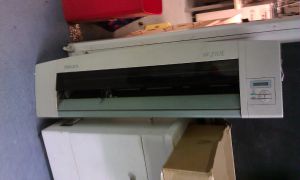Equipment/Selex: Difference between revisions
(This printer is not found in the space.) |
(Marked as Defunct - no longer in the space) |
||
| Line 3: | Line 3: | ||
|image=Plotter in london Hackspace.jpg | |image=Plotter in london Hackspace.jpg | ||
|category=Equipment | |category=Equipment | ||
|subcat= | |subcat=Defunct | ||
|status= | |status=Unknown | ||
|reqtraining=no | |reqtraining=no | ||
|acnode=no | |acnode=no | ||
Latest revision as of 09:56, 20 April 2016
Status
Location: On the top library shelf to the left facing the classroom. Status: It works! It can be slow for large complex plots.
Description
We have a Selex SR-710E A0 black & white printer. It is really really old and quite slow but it does work. Because it was made in around '94, it uses HP-GL/2 and HP-RTL as input. Apparently it is the same as the TechJet 720c, and Selex was bought out by Canon, which is why there is little information about them on the web.
HP-GL/2 is a vector format designed for plotters. It's like a more terse version of Logo. Because this is actually a printer pretending to be a pen-plotter it can't draw lines in any order like a pen-plotter can. So when you send the HP-GL/2 data to the printer, it converts it to an internal spatially indexed format, so that it can print it out. This can take a long time! And it also can't stream vector data, so the printer can run out of memory.
HP-RTL is a format used for printing raster data. You can switch between HP-GL/2 mode and HP-RTL mode as you like within a single page, and unlike HP-GL/2, HP-RTL images can be streamed, if transmitted in a certain way. HP-RTL is more complicated than HP-GL/2 and I haven't tried printing any yet. But if you want to print a huge photo or something, that is the way to go.
The readable, but long spec for HP-GL/2 and HP-RTL is here: http://www.hpmuseum.net/document.php?catfile=213
Ink
Black, Canon BC-01 definitely works. The map near the wall was printed with one of these.
BC-02 may work, but Tom tried two and neither worked.
You can get remanufactured cartridges for less than £10. If you are going to buy one, get BC-01.
Initialising the printer
1. Turn it on (the switch is on the right hand end), and wait for a bit. The display should say stuff about the firmware (copyright 1994!), and eventually settle on 'Unloaded'.
2. Insert the paper. To do this, lift the two lever things, and slider the right hand stop to the appropriate width of the paper. Then put the paper in, make sure it is straight and lower the two levers. I'm not sure exactly how far to put the paper in, or if it detects where it is. I think the edge should be a few cm in front of the white line.
3. When you insert the paper the printer will start whirring. Press 'Online', and it will suck in the paper and start doing printery things. Eventually it will say 'Online' and something about cooling the ink for a few seconds. You are now ready to print!
Sending the print job
The printer is connected via a USB-to-serial adapter to Lovelace. To print, simply cat your HP-GL/2 file into /dev/ttyUSB0 or something like that. HP-GL/2 files have an extension of ".plt" or ".hpgl". So your command might be:
cat myplot.plt > /dev/ttyUSB0
This command will block, and while it is executing the printer will start a count-up timer, with an ASCII busy animation: *+-+*+- etc. This means that it is processing the data. Eventually (~15 minutes for a simple A1 plot), it will suddenly start printing!
Creating plot files
This is the tricky part! Apparently Inkscape can output HP-GL/2. And suppooosedly CUPS can be set up to print to it, and this will probably work for simple plots, but for complex ones it is better if you can get proper HP-GL/2 output from whatever you are trying to print.
For the A1 map near the door I wrote an HP-GL/2 output module for my map program.
CUPS
Apparently it can also be made to work with CUPS. The printer should be set (using the menu buttons) to:
Protocol: AUTO (which really means HPGL2/RTL). Serial: 9600 baud, 8N1 serial (note that the traditional default is 2400 7E1).
Then tell CUPS it is a normal Design jet 500 (or use the driver of the HP DesignJet 650C; which is the best HPGL2 driver - but change the paper to 24inch).
Mac users can do the same - except they need to first install [CUPS serial drivers]. Once done - the serial device will show up - when in doubt - go to localhost:631 and observe.
Windows
Windows can print to HP-GL/2 printers, and I have got it to work using XP. It printed the word "Test" fine, however, it did take 50 minutes to print a fairly complex A4 PDF. Also check the links below for drivers. YMMV.
XP likes to stick the USB to Serial on a random COM port (like COM15) - Check under Device Manager (right click My Computer and go to Hardware), make sure it's set at 9600 baud, put HP-GL2 printer on COM15.
